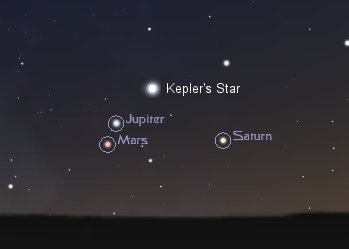
For this December's meeting of the GTAS I will present my biennial program In Search of the Star of Bethlehem. I've been alternating this program with Biblical Cosmology, as a change of pace.
This article will supplement and illuminate the presentation, not replace it. Here we'll look at the origins of the search for what became known as the Star of Bethlehem and of the search for what the star was. We'll start at the beginning with the only reference to the star found in the Bible, in the second chapter of Matthew. The translation here is from the New American Bible.
After Jesus' birth in Bethlehem of Judea during the reign of King Herod, astrologers from the east arrived one day in Jerusalem inquiring, “Where is the newborn King of the Jews? We observed his star at its rising and have come to pay him homage.” At the news King Herod became greatly disturbed, and with him all Jerusalem. Summoning all of the chief priests and scribes of the people, he inquired of them where the Messiah was to be born. “In Bethlehem of Judea”, they informed him. “Here is what the prophet has written: And you, Bethlehem, land of Judah, are by no means least among the princes of Judah, since from you shall come a ruler who is to shepherd my people Israel”. Herod called the astrologers aside and found out the exact time of the star's appearance. Then he sent them to Bethlehem after having instructed: “Go and get detailed information about the child. When you have found him, report it to me so that I may go and offer him homage too.” After their audience with the king, they set out. The star, which they had observed at its rising went ahead of them until it came to a standstill over the place where the child was. They were overjoyed at seeing the star, and on entering the house, found the child with Mary his mother.
The story is told in the Gospel of Matthew. Who was Matthew? We don't know. Scholars are quite sure that he wasn't the apostle Matthew. Much of the material of the Gospel of Matthew is taken from the Gospel of Mark, written by John Mark, a young associate of St. Paul. A source for Mark, and possibly Matthew and Luke was a now lost source, called by Biblical scholars called Q, from the German word Quelle, which means simply Source. It could have been written or even an oral tradition of the sayings of Jesus.
Mark's Gospel is dated to about AD 70. While Matthew's is somewhat later. He seemed cognizant of the destruction of Jerusalem in AD 70. Matthew's audience for his Gospel seems to be Jewish Christians, and he emphasizes that Jesus is the fulfillment of Biblical prophesy.
The only other nativity narrative in the Gospels is that of Luke. Though not contradictory, the nativity stories of Matthew and Luke are completely different with few points in common. One wonders how Luke could omit the visit of the magi or the flight to Egypt, had he known. Maybe he didn't. Luke's audience was more non Jewish and not as interested in Jesus as fulfillment of biblical prophesy.
Most Biblical scholars agree that the Gospels are not biographies in the modern sense of the word, and may not be, I hate saying this, the Gospel truth. Where did the writer of Matthew get the goings on in King Herod's court some 70 years after the fact? I suppose there were leaks, just like there's leaks in our President George III's current administration. Even so there's bound to be some alteration and embellishment over time. This tendency to embellish stories more with time is seen with the apocryphal or “hidden” gospels written later on which relate, rather fanciful accounts of Jesus' childhood.

The search for the Star of Bethlehen began in 1604, with the appearance of a supernova in the constellation of Ophiuchus. At the bottom of this page is a representation of the sky near the end of twilight on the night Johannes Kepler discovered the supernova, October 9, 1604. It was near a close grouping of the three planets Jupiter Saturn and Mars. He calculated a similar grouping of the same three planets in 6 B.C. after Jupiter and Saturn pass three times in a triple conjunction the previous year.
He speculated that a nova appeared near that grouping too, and that the appearance of the planets and the “New” star prompted the magi to journey to Judea to pay homage to the newborn King of the Jews. The question is: was there a “new” star or a nova or supernova visible near the planets in 6 BC?
That and other speculation about the Star of Bethlehem will be presented at the December 2nd meeting.
This year's program has revamped visuals and animations to illustrate the search for the star. See you there!
Questions? Send Email to me at bob@bjmoler.org
Updated: